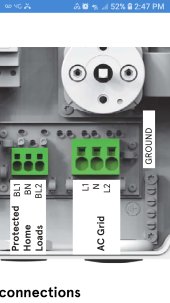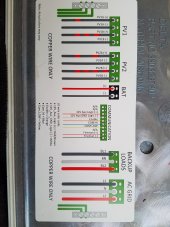could you give some details on how you've wired your system? Pictures would be great too. I have one and I'd like to use it the same way, just keep hearing horror stories of how these blow up if not wired perfectly.
Hi Denwa,
I cant speak for the blowing up part but having used it for several months now, i will admit its a spooky inverter and best not to do anything to anger it.
What i mean is take precautions to build your system so nothing emergency ever needs to happen, for example...
Make sure your fuses/breakers are sized so they will never trip under normal circumstances.
If off grid, dont hook up more array power on input than your 120/240 circuit and battery inverter can handle. Im not sure it would be wise to run this past 4500w. Early in its life, i connected two arrays, a 2.2kw and a 2350w. When it has that much power to work with and it sees an issue with power factor it automatically tries to correct it and will use its full 6kw capability to do so. It literally blew up my battery inverter under these circumstances with 5500w on the display. I cant say for sure on details but it does not act tame at high power levels. Maybe on grid it would be ok but something seems way less stable than my other 3.5kw emerson. Another glitch i noticed today, first time ive ever seen this, it was reading bogus power numbers like neg and positive 12378 in 5 digits. I scroll through menus and grid current is reading 50A, L1 reading 170V L2 reading 95V, i grab a meter and check, nope, L1 annd L2 are 121.xx. so i do the math on pv measured input 375v@4A = 1500W keep in mind, its not faulted so it knows the actual voltage values are fine but its just not displaying corectly. So i switch array off and 240 supply to inverter off wait a minute. Power up. All values are correct. Only thing that was different is my wife acidentally turned the heat off last night and temp dipped to 38°. So its maybe not an outdoor inverter at least not in colder climates.
For what it cost and efficiency lerformance, treat it nice and who knows, it may run for years! I certainly cant complain, it doesnt go offline at every whim like some units do. Its a real workhorse and extremely fast efficient mppt. Conversion efficiency is real good too.
How to connect, first find you tube vid on afci circuit disable, pop it apart and perform the minor surgery. If you do not, the software will occasionally be stopping the power flow and while ive no proof of this, when engineers design safety things usually the equipment safety is the last thing they worry about so if they get power shut off and save the day from a fire its a win, we dont worry if the inverter is trash afterwards. Besides its glichy, i tried it for a while and it would trip out occasionally while my arrays met the iso,ation resistance requirement with ease.
Then connect the ground to bar and the L1 N L2. 120N120 and pv1+ and pv1-
And your good to go, just make sure the polarity is right on your pv input.





